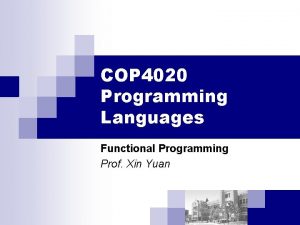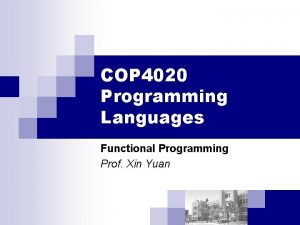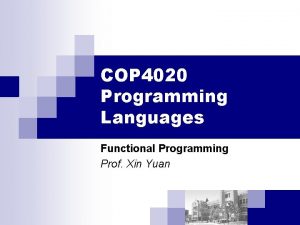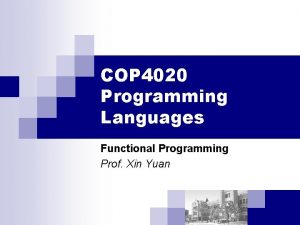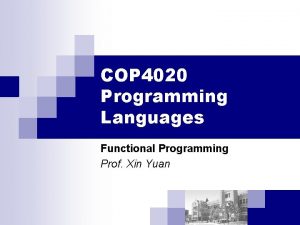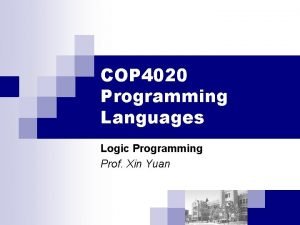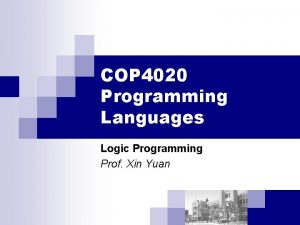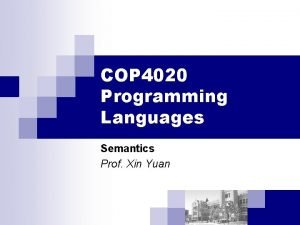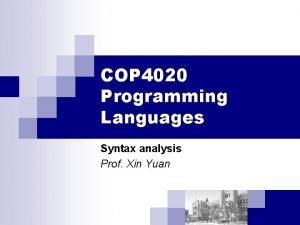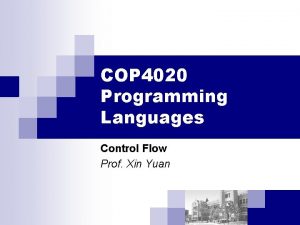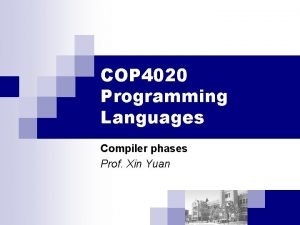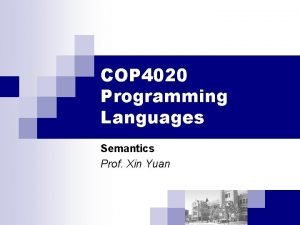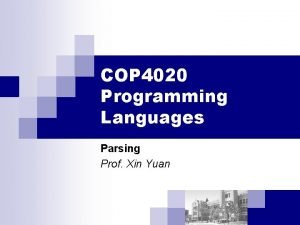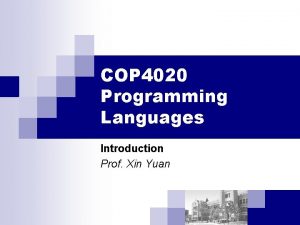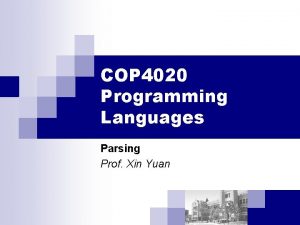COP 4020 Programming Languages Functional Programming Prof Xin
















- Slides: 16

COP 4020 Programming Languages Functional Programming Prof. Xin Yuan

Topics n Functional programming with Scheme ¨ 12/4/2020 Language constructs COP 4020 Spring 2014 2

Data Structures in scheme n n n An expression operates on values and compound data structures built from atoms and lists A value is either an atom or a compound list Atoms are ¨ ¨ ¨ n Numbers, e. g. 7 and 3. 14 Characters: #a Strings, e. g. "abc" Boolean values #t (true) and #f (false) Symbols, which are identifiers escaped with a single quote, e. g. 'y The empty list () When entering a list as a literal value, escape it with a single quote Without the quote it is a function invocation! ¨ For example, '(a b c) is a list while (a b c) is a function application ¨ Lists can be nested and may contain any value, e. g. '(1 (a b) ''s'') ¨ 12/4/2020 COP 4020 Spring 2014 3

Checking the Type of a Value n The type of a value can be checked with ¨ ¨ ¨ ¨ n (boolean? x) (char? x) (string? x) (symbol? x) (number? x) (list? x) (pair? x) (null? x) ; is x a Boolean? ; is x a character? ; is x a string? ; is x a symbol? ; is x a number? ; is x a list? ; is x a non-empty list? ; is x an empty list? Examples (list? '(2)) #t ¨ (number? ''abc'') #f ¨ n Portability note: on some systems false (#f) is replaced with () 12/4/2020 COP 4020 Spring 2014 4

Working with Lists n n n (car xs) returns the head (first element) of list xs (cdr xs) (pronounced "coulder") returns the tail of list xs (cons x xs) joins an element x and a list xs to construct a new list (list x 1 x 2 … xn) generates a list from its arguments Examples: ¨ ¨ ¨ ¨ ¨ 12/4/2020 (car '(2 3 4)) (car '(2)) (car '()) (cdr '(2 3)) (car (cdr '(2 3 4))) (cdr '(2)) (cons 2 '(3 4)) (list 1 2 3) COP 4020 Spring 2014 5

Working with Lists n n n (car xs) returns the head (first element) of list xs (cdr xs) (pronounced "coulder") returns the tail of list xs (cons x xs) joins an element x and a list xs to construct a new list (list x 1 x 2 … xn) generates a list from its arguments Examples: ¨ ¨ ¨ ¨ ¨ 12/4/2020 (car '(2 3 4)) 2 (car '(2)) 2 (car '()) Error (cdr '(2 3)) (3) (car (cdr '(2 3 4))) 3 (cdr '(2 3 4))) (4) (cdr '(2)) () (cons 2 '(3)) (2 3) (cons 2 '(3 4)) (2 3 4) (list 1 2 3) (1 2 3) ; also abbreviated as (cadr '(2 3 4)) ; also abbreviated as (cddr '(2 3 4)) COP 4020 Spring 2014 6

How to represent some common data structure? n Everything is a list: ¨ Array? int A[4]= {1, 2, 3, 4} ¨ 2 -d array: int a[4][4] = {{0, 0, 0, 0}, {1, 1, 1 , 1}, {2, 2, 2, 2}, {3, 3, 3, 3}} ¨ Structure (array)? struct ex {int a; char b; } ¨ An array of a structure? struct ex {int a; char b; } aa[3] = {{10, ‘a’}, {20, ‘b’}, {30, ‘c’}}; ¨ A tree? n n Can use pre-order traversal list form (root left_tree right_tree) The major difference between scheme data structures and C++ data structures? -- no random access mechanism, list items are mostly accessed through car and cdr functions. 12/4/2020 COP 4020 Spring 2014 7

The “if” Special Form n Special forms resemble functions but have special evaluation rules ¨ n Evaluation of arguments depends on the special construct The “if” special form returns the value of thenexpr or elseexpr depending on a condition (if condition thenexpr elseexpr) n Examples (if #t 1 2) ¨ (if #f 1 "a") ¨ (if (string? "s") (+ 1 2) 4) ¨ (if (> 1 2) "yes" "no") ¨ 12/4/2020 COP 4020 Spring 2014 8

The “if” Special Form n Examples (if #t 1 2) 1 ¨ (if #f 1 "a") "a" ¨ (if (string? "s") (+ 1 2) 4) 3 ¨ (if (> 1 2) "yes" "no") "no" ¨ 12/4/2020 COP 4020 Spring 2014 9

The “cond” Special Form n A more general if-then-else can be written using the “cond” special form that takes a sequence of (condition value) pairs and returns the first value xi for which condition ci is true: n (cond (c 1 x 1) (c 2 x 2) … (else xn) ) Note: “else” is used to return a default value n Examples (cond (#f 1) (#t 2) (#t 3) ) ¨ (cond ((< 1 2) ''one'') ((>= 1 2) ''two'') ) ¨ (cond ((< 2 1) 1) ((= 2 1) 2) (else 3) ) ¨ (cond (#f 1) (#f 2)) ¨ 12/4/2020 COP 4020 Spring 2014 10

The “cond” Special Form n Examples (cond (#f 1) (#t 2) (#t 3) ) 2 ¨ (cond ((< 1 2) ''one'') ((>= 1 2) ''two'') ) ''one'' ¨ (cond ((< 2 1) 1) ((= 2 1) 2) (else 3) ) 3 ¨ (cond (#f 1) (#f 2)) error (unspecified value) ¨ 12/4/2020 COP 4020 Spring 2014 11

Logical Expressions n Relations ¨ n Boolean operators ¨ n Numeric comparison operators <, <=, =, >, >= (and x 1 x 2 … xn), (or x 1 x 2 … xn) Other test operators (zero? x), (odd? x), (even? x) ¨ (eq? x 1 x 2) tests whether x 1 and x 2 refer to the same object (eq? 'a 'a) #t (eq? '(a b)) #f ¨ (equal? x 1 x 2) tests whether x 1 and x 2 are structurally equivalent (equal? 'a 'a) #t (equal? '(a b)) #t ¨ (member x xs) returns the sublist of xs that starts with x, or returns () (member 5 '(a b)) () (member 5 '(1 2 3 4 5 6)) (5 6) ¨ 12/4/2020 COP 4020 Spring 2014 12

Lambda Calculus: Functions = Lambda Abstractions n A lambda abstraction is a nameless function (a mapping) specified with the lambda special form: (lambda args body) n n where args is a list of formal arguments and body is an expression that returns the result of the function evaluation when applied to actual arguments A lambda expression is an unevaluated function Examples: (lambda (x) (+ x 1)) ¨ (lambda (x) (* x x)) ¨ (lambda (a b) (sqrt (+ (* a a) (* b b)))) ¨ 12/4/2020 COP 4020 Spring 2014 13

Lambda Calculus: Invocation = Beta Reduction n n A lambda abstraction is applied to actual arguments using the familiar list notation (function arg 1 arg 2. . . argn) where function is the name of a function or a lambda abstraction Beta reduction is the process of replacing formal arguments in the lambda abstraction’s body with actuals ¨ n Defined in terms of substitution: ((λV. E) E′) is E[V : = E′] Examples ( (lambda (x) (* x x)) 3 ) (* 3 3) 9 ¨ ( (lambda (f a) (f (f a))) (lambda (x) (* x x)) 3 ) (f (f 3)) where f = (lambda (x) (* x x)) (f ( (lambda (x) (* x x)) 3 )) where f = (lambda (x) (* x x)) (f 9) where f = (lambda (x) (* x x)) ( (lambda (x) (* x x)) 9 ) (* 9 9) 81 ¨ 12/4/2020 COP 4020 Spring 2014 14

More Lambda abstractions n Define a lambda abstraction that takes three parameters and returns the maximum value of the three. n Define a lambda abstraction that takes two parameters, one scheme arithmetic expression (e. g. (+ 1 2 4)), and the other one a number. The function return true (#t) if the expression evaluate to the number, false (#f) otherwise. 12/4/2020 COP 4020 Spring 2014 15

More Lambda abstractions n Define a lambda abstraction that takes three parameters and returns the maximum value of the three. ¨ n Define a lambda abstraction that takes two parameters, one scheme arithmetic expression (e. g. (+ 1 2 4)), and the other one a number. The function return true (#t) if the expression evaluate to the number, false (#f) otherwise. ¨ n (lambda (x y z) (if (> x y) (if (> x z) (if (> y z))) (lambda (x y) (if (equal? x y) #t #f) Functions are used much more liberally in scheme (compared to C++); the boundary before data and program is not as clear as in C++. 12/4/2020 COP 4020 Spring 2014 16
 Good cop bad cop interrogation
Good cop bad cop interrogation Cop 1 cop 2
Cop 1 cop 2 Senarai kod pendapatan dan potongan gaji
Senarai kod pendapatan dan potongan gaji As/nzs 4020
As/nzs 4020 Center for army analysis
Center for army analysis Real-time systems and programming languages
Real-time systems and programming languages Cs 421 uiuc
Cs 421 uiuc Multithreaded programming languages
Multithreaded programming languages Programming languages levels
Programming languages levels Introduction to programming languages
Introduction to programming languages Plc programming languages
Plc programming languages Joey paquet
Joey paquet Imperative programming languages
Imperative programming languages Alternative programming languages
Alternative programming languages Strongly typed vs weakly typed
Strongly typed vs weakly typed Transmission programming languages
Transmission programming languages Adam doupe cse 340
Adam doupe cse 340

















